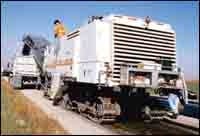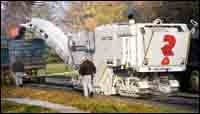The 700-hp RX-700 introduced this year is the third machine in Roadtec's line, offering buyers three-track or four-track options between the company's 600- and 950-hp machines.
- Average Cold Planer Costs
- Milling Machine Specs: 72- to 87-Inch Models
- Dynapac
- Wirtgen America
- Caterpillar
- Terex Roadbuilding
- Roadtec
- Marini
Only six manufacturers build milling machines (also known as cold planers or pavement profilers), so the recent additions of three new machines to the 20 models with cutting widths from 72 to 87 inches is big news.
Developments reflect the road-building industry's growing acceptance of cold milling and reuse of reclaimed asphalt pavement (RAP). Rising demand for pavement profiling and cold planers is fueling innovation in horsepower and weight combinations and refinement of milling heads.
With the 41,300-pound PM-201 introduced last month, Caterpillar added a second milling machine to its line and created the lightest model in this size class. The four-track cold planer's 550-hp C18 diesel packs more power than machines that weigh 20,000 pounds more, and its standard 83-inch cutting width is as broad as anything up to 600 horsepower and 75,000 pounds.
Roadtec joined Wirtgen in the big horsepower gap between 625 and 800 with the RX-700. A couple of years ago, Wirtgen replaced its 600-hp 2100DC with the W2100. The W2100 and Roadtec's RX-700 are both powered by Cat's C18 six-cylinder rated at 700 horsepower. Standard milling widths are common, at about 80 inches. The RX-700 in four-track configuration is about 7,000 pounds lighter than its Wirtgen competition, and its optional cutting-width extension reaches 86 inches while the W2100 stretches to 108 inches.
Roadtec offers three- and four-track versions of all three of its half-lane milling machines. The entire line is redesigned with increased engine horsepower for the RX-500 and RX-900 and front and rear moldboards that slope 10 degrees.
Terex Roadbuilding aims to develop the PR-950 into the only milling machine over 800 horsepower that weighs less than 75,000 pounds. They've chosen a Cummins diesel rated at 950 horsepower. The idea is to be able to load a machine with capability to profile pavements up to 150 inches wide on a lowboy and transport it using standard overweight permits in finicky states such as California and Ohio. Target weights are 73,000 pounds for the three track PR-950, and 78,500 for the four-track version.
Terex's cutter housing is tapered — narrower at the bottom than the top. It's said to be a critical refinement.
"Closing up the space in the housing around the rotor forces material to the center of the drum faster, where it can exit to the conveyor belt. Moving more material faster increases production," says Larry Jack, vice president of marketing and sales support at Terex Roadbuilding. "And because you're not grinding longer than necessary on that material, it reduces wear on the bits and holders."
Jack says most contractors can expect to spend more on cutter bits, at $2.50 to $3.50 each, over five years than they will pay for their milling machine. But as state road specifiers have chosen to recycle more asphalt, it has forced contractors to look beyond rotor cost. There are great savings in milling machines that deliver RAP ready for the asphalt plant.
Taking RAP to the asphalt plant without secondary crushing slashes production costs, but requires the milling machine to size material as it comes up off the road. It has changed the way manufacturers think about rotors and housings. For example, the bulkhead in front of Terex's cutter housing rides on the existing pavement even at cutting depths as shallow as one inch. Company literature says this keeps the machine from lifting slabs of asphalt.
"We're seeing more use of a gradation grid," says Jeff Wiley, vice president of sales and marketing at Wirtgen. The company recently redesigned a heavier gradation grid. "It allows the machine to size material as you bring it up off pavement so you don't have to crush it before you can use the RAP."
As an option, Caterpillar will mount a hydraulically operated front door in the housing. It adjusts down pressure to improve material sizing.
Road specifiers are also influencing rotor designs with demands for smoother pavement.
"We're starting to see more customers who want 5/16- to ¼-inch tooth spacing (5/8 inch between teeth is pretty common) — it creates a smoother milled surface," says Wiley. "It's still a relatively new idea in the U.S. — not a huge shift or anything — but in some isolated cases there are states writing it into their milling specs. I think we'll see more of it in the future."
Variations in the milled surface tend to reflect through the repaved road, and the industry is becoming more aware of how the alignment of teeth in a milling machine's cutter head can affect pavement smoothness.
"As the drum wears, dimensions change on the drum," says Wiley. "When you replace a tooth or holder, it can create a groove in the pavement if the new tooth doesn't match the diameter of the worn teeth."
Wirtgen is the only manufacturer that builds all of its own cutter-head components, rather than sourcing holders and teeth from an OEM. The German manufacturer's claim to bigger, heavier, more robust cutter head components is perhaps supported by the fact that Wirtgen markets the heaviest machine in each of the horsepower classes in which it participates.
Other manufacturers are buying tooth systems such as Kennametal's KPF301. It's a three-part assembly. Bases are securely welded to the drum, virtually becoming part of the drum's flighting. A tooth holder fits into this base and secures the tooth.
"If you hit a manhole cover and break a holder, you knock it out and hammer another one into place," says Jack. "Welded cutters are cheaper — the tooth holder is $5, but if you knock a holder off, you have to weld it back onto the drum. The holders in a quick-change cutter will cost $20, which can increase the cost of the cutter $12,000 to $15,000."
Quick-change tooth holders are not only easier to replace, but the system is also designed to maintain the tooth's angle of attack. Replaced teeth are more likely to line up with worn teeth.
"Some contractors may not need a quick-change cutter if they're milling down a rural highway where there aren't a lot of surprises to break teeth on," says Jack. "That's why we still offer both."
Other milling-head options include systems that allow the head to be changed in a couple of hours or less. For the larger half-lane mills — 700 horsepower and up — this usually offers the opportunity to quickly change from 5/8-inch tooth spacing to ¼-inch, and there are some advantages when changing milling widths.
Half-lane milling machines under 600 horsepower tend to offer greater flexibility, with cutter heads that can be set up to cut two, three or four feet wide. It allows these units to be used in road widening or to open trenches for utility crossings.
Like the pavers that follow them on most road projects, milling machines are employing contact and non-contact grade-controls, integrating them with the electronics tied to their hydraulic systems to deliver precise surfaces. They are innovations that parallel road-rehab specifications. For anyone with a big stake in pavement-milling efficiency, there's good reason to stay on the lookout for important changes such as significantly reduced turning radius or improved productivity at easier-to-transport weights.
| Web Resources | ||
| Bitelli (a Caterpillar company) www.bitelli.it | ||
| Caterpillar www.cat.com | Dynapac www.dynapac.com | |
| Marini America www.mariniamerica.com | Roadtec www.roadtec.com | |
| Terex Roadbuilding www.terexrb.com | Wirtgen www.wirtgengroup.com | |






